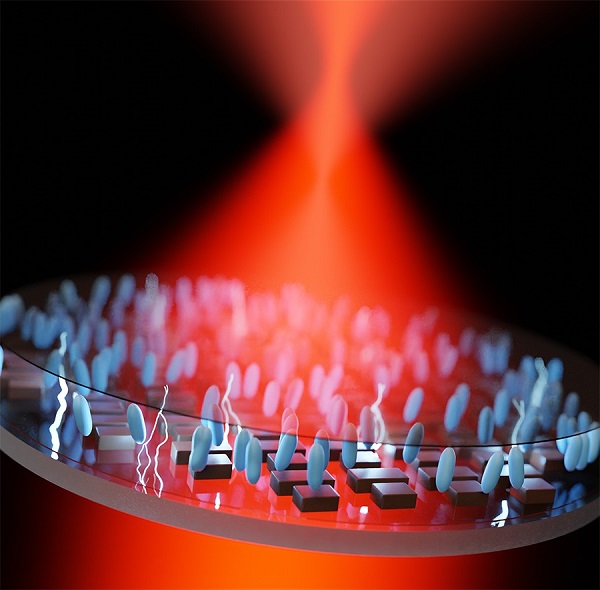A metalens developed by researchers from Cornell University and Samsung Advanced Institute of Technology can be focused using voltage rather than by mechanically moving its components. The lens, a proof of concept, is the first of its kind, the researchers reported, and opens possibilities to compact varifocal lenses. Those lenses could be used in imaging applications that include satellites, telescopes, and microscopes.
Researchers merged a metalens with liquid crystals to tailor the metalens’s local phase response. This allowed the researchers to vary the focus of the metalens in a controlled way by varying the voltage applied across the device.

Conceptual rendering of an ultrathin, electrically tunable metalens developed by Cornell and Samsung engineers. Courtesy of Daniil Shilkin.
The combination, said Melissa Bosch, first author and a doctoral student in the lab of Gennady Shvets, professor of applied and engineering physics and senior author of the paper, yielded an ultrathin, electrically tunable lens that was capable of continuous zoom. It also demonstrated up to 20% total focal length shift, she said.
Samsung researchers plan to develop the technology for use in augmented reality glasses, Bosch said. She said there are many other possible applications for the technology: replacing optical lenses in satellites, spacecraft, drones, night-vision goggles, endoscopes, and other contexts where space and weight are priorities.
Maxim Shcherbakov, a postdoctoral associate in the Shvets lab and corresponding author of the paper, said researchers have made progress in marrying liquid crystals to nanostructures for the past decade. Nobody, however, had applied this to lenses, he said.
“For instance,” Shcherbakov said, “this lens works at a single wavelength, red, but it will be much more useful when it can work across the color spectrum — red, green, blue.”
The Cornell group is working toward a multiwavelength varifocal version of the metalens using the existing platform as a starting point.
“The optimization procedure for other wavelengths is very similar to that of red. In some ways, the hardest step is already finished, so no, it is simply a matter of building on the work already done,” Bosch said.
The work was supported by the Global Research Outreach program of the Samsung Advanced Institute of Technology and by the Cornell Center for Materials Research with funding from the National Science Foundation and the U.S. Office of Naval Research.
The research was published in Nano Letters (www.doi.org/10.1021/acs.nanolett.1c00356).